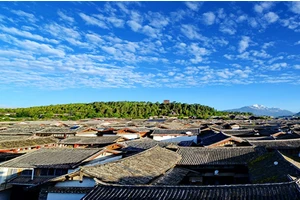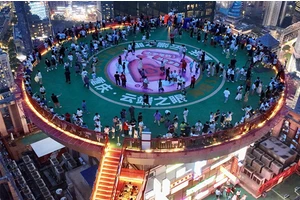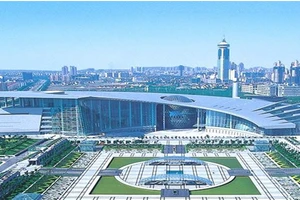Datang tourist attractions
1. Introduction of tourist attractions in Shixing, Guangdong.
The main places of interest in Shixing are "the treasure house of species, the pearl of Lingnan", "the world biosphere reserve"-Chebaling National Nature Reserve, the national key cultural relics protection unit, and the "largest enclosure in Lingnan"-Mantang Hakka Wai, Donghu Ping Folk Culture Village, Shensuo Tongzhong Village, Han Dynasty Castle, Qin and Han beacon towers, eco-Yaoxiang deep crossing water, and a large number of hot springs, green mountains, green waters and waterfalls. In 2008, "Danxia Mountain-Donghu Ping Folk Culture Village-Mantang Hakka Dawei-Chebaling Reserve" was selected as "Top Ten Routes in go on road trip, Guangdong". In November 2009, Shixing County won the honorary title of "The Most Beautiful Town in China" among the top 50 in China. In 2010, it won the title of "Excellent Eco-tourism County in China". In 2011, it won the title of "China's hometown of walled buildings culture" and "China's geographical name cultural heritage-Millennium ancient county". Specialty: mushrooms, fungus, dried bamboo shoots, horseshoes, etc.
2. Guangdong Shixing tourism must-see attractions
Xiashan in Renhuadan County, yunmen temple in Ruyuan County, Grand Canyon in Ruyuan County, Nanhua Temple in Shaoguan, Eight Ridges in Wai House in Shixing County, Lingxi Park in Renhua County, Yunji Mountain in Xinfeng County, Tianjing Mountain in Ruyuan County, Nanxiong County, Zhuji Lane and Meiling,
3. A complete collection of tourist attractions in Shixing
Shixing County, which belongs to Shaoguan City, Guangdong Province, is located in the north of Guangdong Province, at the southern foot of Nanling Mountains, in the upper reaches of Beijiang River, with a total area of 2,131 square kilometers. Known as the "granary in northern Guangdong" in ancient times, it is now known as the "Pearl of Nanling". Recommended interesting attractions:
1. Mantang Hakka Wai
2. Tongzhongzhai
3. Chebaling Nature Reserve
4. Guilu (Zhang Fakui's former residence)
5. Shixia Ancient Village
6. Daozhuyan
7. Chongyi Church
8. Donghu Ping Folk Culture Village
9. Nanling Red Desert Scenic Area
10. Danfeng Park
4. Shixing travel guide must visit scenic spots
1 Chebaling Nature Reserve
2. Cheung Wai Tsuen Wai House
3. Mantang Hakka Wai
4. Tongzhongzhai
5. Donghu Ping Folk Culture Village
6. Shendu Water Ecological Zone
7. Nanshan nature reserve
8. Qiziwo Ancient Site
9. Zhang Jiuling's former residence
10. Mengzi Mountain Scenic Area
5. A complete collection of Shixing scenic spots
There. The tourist attractions include Hanshan Temple, um, Yerendong. . . Yangtou toulai
6. What are the scenic spots in Shixing County?
The fiscal revenue of Lechang county (city) in 2010 was 305 million yuan. I don't know the origin, please check it yourself.
7. Shixing famous scenic spots
1. Yangmingshan National Forest Park in Hunan Province
Yangmingshan National Forest Park, located in the southwest of Hunan Province, the suburb of Yongzhou City and the northeast corner of Shuangpai County, belongs to the Wuling Mountains and is known as the "blessed land of Lingshan" on earth. The scenic spot covers an area of 114.5 square kilometers, with manjuji and Rhododendron Sea as the key tourist areas. There are Wanshouquan, more than 10,000 mu of wild Rhododendron trees, Baiyun Temple and other scenic spots, as well as off-season vegetables such as alpine yacon, which is known as the king of fruits, local snacks such as smoked bacon, distiller's grains meat and milk tofu, as well as tourist souvenirs such as bamboo handicrafts and ventilated bamboo chopsticks.
2. Yongzhou Jiangyong went to Gan Tang Ancient Village.
ShangGan Tang Village is the sixth batch of national key cultural relics protection units announced by the State Council in May 2006. It is 25 kilometers southwest of Jiangyong County, and there are 453 households. Except for 7 families who moved into the village after the founding of the People's Republic of China, the others are Zhou clan people. Zhou clan people have settled in ShangGan Tang Village since before the Song Dynasty, and they have been multiplying from generation to generation, which continues to this day. This village is a thousand-year-old ancient village discovered so far in Hunan Province. Up to now, there are still more than 200 ancient houses in the Ming and Qing Dynasties in the village. In addition, a large number of Ming and Qing buildings have been left in the village, such as Wenchang Pavilion in the 48th year of Wanli, the gatehouse in the 6th year of Hongzhi, the Buying Bridge in the 10th year of Jiajing, and the stone fence in the 2nd year of the Republic of China. There are also a number of ancient buildings with obvious Song characteristics.
3. Liuzi Temple
Liuzi Temple, located in Liuzi Street, west of Xiaoshui, Yongzhou, was founded in 1056, the third year of Renzong in the Northern Song Dynasty. In the 14th year of the Southern Song Dynasty (AD 1144), it was rebuilt in the 3rd year of Guangxu in the Qing Dynasty (AD 1877). Liuzi Temple covers an area of more than 2,000 square meters, with brick and wood structure, facing Yuxi and backed by Qingshan. The temple gate is engraved with Liuzi Temple's three-character stone carving, with couplets on both sides. When you enter the gate, you can see that the temple has three entrances and three openings. First, it is a stage with two eaves and eight columns. After that, it went to the second entrance to the middle hall, and then to the third entrance. It was the main hall, and there was a statue of Liu Zongyuan in the hall for people to sacrifice.
4. Qianjiadong National Forest Park in Hunan Province
Hunan Qianjiadong National Forest Park is located in Gaozeyuan Forest Farm, Jiangyong County, Yongzhou City, Hunan Province, 20 kilometers away from the county seat and 150 kilometers away from Guilin, a tourist attraction, with a planned total area of 4,430.93 hectares. Geographical coordinates of the park: east longitude 110 08 ′ 20 ″-110 13 ′ 25 ″, north latitude 25 15 ′ 03 ″-25 22 ′ 05 ″. Qianjiadong National Forest Park in Hunan Province is located in the Dupangling Mountain Range, one of the five mountains, with the lowest elevation of 304.2 meters at Shuanghekou and the highest elevation of 1803.9 meters at Tianmenling, with a relative height difference of about 1500 meters. Qianjiadong Forest Park in Hunan is mainly composed of natural scenery, which is mainly divided into four scenic spots: Xiaoguyuan Scenic Spot, Guzhai Lake Scenic Spot, Tianmenling Scenic Spot and Yaopanwang Square.
5, Yongzhou Wuxi Forest of Steles Scenic Area
Wuxi Beilin Scenic Area, located in Wuxi South Road, Qiyang County, Yongzhou City, is more than 50 kilometers away from Yongzhou City. It is a treasure house for studying stone tablet culture. The scenic spot has successively won the honorary titles of national AAAA tourist scenic spot, national key cultural relics protection unit, Hunan provincial scenic spot and Hunan provincial patriotic education base. There are 505 cliff stone carvings in the scenic spot, including 17 in Tang Dynasty, 116 in Song Dynasty, 5 in Yuan Dynasty, 84 in Ming Dynasty, 92 in Qing Dynasty and 9 in the Republic of China. The highest one is carved on a 30-meter cliff with a word diameter of 2.3 meters. The lowest is at the foot of the cliff by the stream, with a word diameter of 1 cm.
6. Hunan Shunhuangshan National Forest Park
Shunhuangshan Forest Park is located in Dong 'an County, Hunan Province. It is located in Damiaokou, 29 kilometers southwest of the county, bordering quanzhou county in the south and Xinning County in the west and north. The park is 42.5 kilometers long from north to south and 17.5 kilometers wide from east to west, with a total area of 14,548.6 hectares. It is located in a humid subtropical monsoon climate zone with four distinct seasons. It is the only famous mountain named after the emperor among many famous mountains and rivers in China. Its main peak is 1882.4 meters above sea level, and it is known as "the first peak in Hunan", known as "green pearl", "ecological kingdom" and "butterfly kingdom".
7. Li Family Courtyard in Qiyang
Lijia Courtyard is the seventh batch of national key cultural relics protection units announced by the State Council in May 2013. It is located in longxi village, Panshi Town, Qiyang County, Hunan Province, 1500 meters away from the exit of Hengkun Expressway, and is a provincial cultural relics protection unit. The Li Family Courtyard was built in the 11th year of Hongzhi in Ming Dynasty (1498), and it took more than 80 years to build one after another until the 10th year of Wanli (1583). It was originally composed of an old house courtyard, a bamboo hanging courtyard, upper and lower houses and a pinzi bookstore. The existing Li Family Courtyard only refers to the upper and lower houses and the Li Family Ancestral Hall. Covering an area of 23,792 square meters, it is rectangular, long from east to west and short from north to south. The whole upper and lower courtyards are an interconnected whole, with pavilions, lanes or terraces connected.
8. Yongzhou Goulan Yaozhai Scenic Area
Goulan Yaozhai Scenic Area is located in Huangjia, Goulan Yao Village, Lanxi Township, Jiangyong County, Yongzhou City, Hunan Province. It is a well-preserved ancestral home of Goulan Yao people and has the reputation of "Xanadu". Up to now, Yaozhai has preserved more than 300 residential buildings in Ming and Qing Dynasties, and there are social altar land, dance pavilions, pavilions and bridges everywhere, among which Panwang Temple, Xianggong Temple, Tiger Temple and Guangong Temple are large. These buildings are exquisite in shape, with upturned cornices, carved beams and painted buildings, which are unique and fully show the wisdom of Yao craftsmen.
9. ningyuan county Confucian Temple Tourist Area in Yongzhou
Ningyuan Confucian Temple, also known as Xuegong, is the fourth batch of national key cultural relics protection units announced by the State Council in November 1996. It is located in the southwest corner of Ningyuan County, Hunan Province. It was originally built in the old city of Hanling Road (now known as Dongcheng), and Song Gande moved here with the county in 1965. Confucian Temple is a representative building of Confucian culture in ancient China. It is the only institution offering sacrifices to famous historical and cultural figures Yezi and running a lawsuit. It is also an educational institution integrating temple and learning in the feudal society of China. Ningyuan Confucian Temple is one of the earliest and most well-preserved two existing Confucian temples in China (including Yemiao Temple, Wenxuanwang Temple, Xuegong Temple, Confucius Temple and Xianshi Temple).
10. Xiaoxiangyuan Water Conservancy Scenic Area in Jianghua Yao Autonomous County
Xiaoxiangyuan Water Conservancy Scenic Area, since 2012, Jianghua has made full use of the opportunity of being included in the "Great Xiangxi Ecological and Cultural Tourism Circle" to start the construction and application of Xiaoxiangyuan Water Conservancy Scenic Area, and vigorously strengthen the infrastructure construction of the scenic area. On October 15, 2013, the thirteenth batch of national water conservancy scenic areas was approved, and the municipal government officially approved the establishment of Hunan Xiaoxiangyuan Water Conservancy Scenic Area Administration on October 20. With a total area of 287 square kilometers, the area is mainly composed of four parts: Xiaoxiangyuan Riverside Scenic Belt, Qiantianhe Reservoir Tourist Resort, Huanglong Mountain Primitive Forest Area and Dalongshan Ecological Tourism Area. It is a comprehensive sightseeing scenic spot combining ecological landscape, natural landscape, human landscape, Yao culture and resources.
11. Zhoujia Courtyard Scenic Spot in Lingling
The ancient building complex of Zhoujia Courtyard in Jianyantou is located in Jianyantou Village, Hexianguan, 18km southeast of Fujiaqiao Town. It was founded in the Jiajing period of Shizong in the Ming Dynasty (1550) and completed in the 30th year of Guangxu in the Qing Dynasty (1904). On June 9-11, 2007, at the international symposium on urban culture held by the Ministry of Construction, the Ministry of Culture and National Cultural Heritage Administration, the awarding ceremony of the third batch of famous historical and cultural towns (villages) in China was held at the opening ceremony of the international symposium on urban culture, which officially became "famous historical and cultural villages in China" and "national key cultural relics protection units".
12. Jiuyi Mountain-Shundi Mausoleum Scenic Area
Shundi Mausoleum is located in Jiuyi Mountain, 30 kilometers south of ningyuan county, Hunan Province. It is the mausoleum temple of Shun Di, one of the "five emperors" of the Chinese nation. Shundi Mausoleum covers an area of 50,000 square meters and is divided into two natural courtyards and nine single buildings. From the outside to the inside, there are Jade Belt Bridge, Yimen, Shinto, Shanmen, Ganmen, Worship Hall, Main Hall, Bedroom, Left and Right Wing, Left and Right Monument Rooms and Monument Gallery, surrounded by three palace walls. Magnificent momentum and rigorous structure, it is the highest and largest mausoleum among the ancestral tombs in China, and is called "the first mausoleum in China".
8. What are the tourist attractions in Shixing, Guangdong?
A: Raoping (half a day -1 day)
1. Qiandong: Green Island Villa.
2. Zhangxi: Icehole Park.
3. Huanggang: Shibi Mountain, Yunfeng Mountain Villa (Orchid). (half a day)
4. Tangxi: Reservoir scenery and fishing village.
5. Sanrao: Daoyun Building. (half a day)
6. Tuolin: Datun Suocheng and Egret Paradise in Western Australia. (half a day)
7. Seamount: Ancient sea erosion site.
8. Xinfeng: Hongfa Temple,
B: Chaozhou (half a day-one day)
1. Urban area: Xufumafu, Jiadi Lane, which is slightly short of Huanggong Temple, Crocodile Sacrifice Platform, Phoenix Tower, Hanwen Gongci Temple, Beige Buddha Lantern, Guangji Bridge, Guangji Bridge Tower, Kaiyuan Town Guochan Temple and Huiru Park. (Half-day) Night: Square Fountain.
2. Phosphorus Creek: Gangshan Reservoir, Hongshan Forest Park, Anek Kuson Sala and Qianguo Mountain. (half a day)
3. Gu Xiang: Xiangpuzhai.
4. Dengtang: Baishuiyan, Hulushan Reservoir in Tiandong, green watermelon. (half a day)
5, returning to the lake: the secluded valley and the forest. (half a day)
6. Phoenix: Tianchi, Fenghuang Reservoir, Fengxi Reservoir, Bijiashan Song Kiln, Wanfengshan Forest Farm, Wanfeng Fell Monkey Waterfall, called Shuikeng Primitive Forest, Sandiequan, Fengxiang Gorge, Fengnan Baizhangtan Waterfall and Tiefan Guanmen Waterfall. (1 day -2 days)
7. Longhu: Longhu Ancient Village. (half a day)
8. Caitang: From Xigong Temple. (half a day)
9. Tun: Meilin Lake. (half a day)
10. Shaxi: Dongshan Lake Hot Spring Resort in Kanroji. (half a day)
11. Dashan Town: Xinluo Lake Canyon.
C: Chenghai District (half a day)
1. Laiwu: seaside, Dalaiwu Fort.
2. Dengfeng Road: Thousand Trees Garden in Cologne.
3. Lianshang: Tashan Ancient Temple.
4. Longdu: Former residence of former US Chen Cifu, Yongning Village.
5. Dongli: Zhanglin Ancient Port.
6. Lianhua: Dehua Folk Culture Theme Park, Lianhua Mountain, Sheng 'an Gu Lou and Nature.
7. Shanghua: Guanshan is surrounded by greenery.
8. Jiangdong Island
9. Xinxi World Shellfish Exhibition Hall
D: Nan 'ao Island (1-2 days)
1. Houzhai: Changshanwei Fort and Huanghuashan National Forest Park.
2. Yun 'ao: Songjing, Prince Building.
3. Qingao: bathing beach, wind farm,
4. Shen 'ao: Guandi Temple, Xiongzhen Pass, Company commanders mansion and Treasure Island.
E, northern suburb of Shantou (half a day)
1. Longquan Rock, Tielin Temple and Pengzhou City.
2. Tropic of Cancer Sign Tower.
3. Shantou University. (half a day)
4. Niu Tianyang Dawei. (half a day)
F: Jieyang (half a day)
1. Battery: the ancient path of air door.
2. Putian: Wanzhu Park.
3. Rongcheng: Huang Qishan, Jieyang Building, Jieyang Xuegong, Jinxianmen, Dongshan Shuangfeng Temple and Ding Richang House. (Half a day) Night: Rongjiang Fountain.
G: Shantou South District (half a day)
1. Zhupu: Jufeng Temple and Dieshi Mountain.
2. Hedu Songzhai, Haocheng Guzhai and Gezhou Qingyun Temple.
3, Zhuishi: Lover Valley, Jiugong Niangniang.
4. CITIC Golf Seaside Resort
H: Chaoyang District (half a day -1 day)
1. Peace: Dafeng Scenic Area and Dongshan Mountain.
2. Tongguan: Lingshan Temple, Ming 'anli, Yangmei Village (Yangweiliao).
3. Xiqiao: Ancient Xueyan.
4. Hexi Reservoir.
5. Haimen: Lotus Peak.
6. Guanbu: Shangcang Guzhai.
7. Shalong: Donglizhai.
8. Golden stove: Yangmei.
I: Chaonan and Huilai (half a day -1 day)
1. Leiling, Red Square.
2. Xiancheng: Cuichanyan Temple.
3. Jinghai: Golden Bay, wind farm, Kebirdtail seaside and lighthouse.
4, Shenquan: Cape Ganquan.
J: Puning (half a day -1 day)
1. Clouds fall: Panlong Pavilion.
2. Da Nanshan Town: Wangtianding.
3. Hongyang: De 'anli Zhongxin Village.
K: Jiexi (1 day)
1. Hepo: Longtan Giant Waterfall.
2. Jingxi Garden: Jingming, Huangmanji Waterfall, Suzhou Garden-style ancient residence Cukeng Village.
3. Ocean: Alpine Golf Resort.
4. Wujingfu: Longjing Reservoir.
5. Mianhu: Guo Building.
L: Fengshun (half a day -2 days)
1. Tangkeng: Hot spring, Longguizhai Waterfall,
2. Baxiang Mountain: Jieling Waterfall.
2. Beidou: Hanshan.
3. Dalonghua: Dragon Whale River rafting.
3. Sand field: Tongguzhang.
M: Tai Po (1-2 days)
1. Dadong: Calyx Building, Lianfeng Village, with terraced scenery, double power reservoir area and alpine waterfalls-water drums.
2. Three Rivers.
3. Xiyan Mountain.
4. Yinna Mountain.
5. Fengxi Forest Resort
6. Tai 'an Square Building
N: Other areas in Meizhou (1-2 days)
1. Wuhua: Qimuzhang, Tanghu Hot Mine Mud Villa.
2. Jiaoling: Changtan Reservoir.
3. Pingyuan: Nantaishan, Dahebei, Wuzhishi, Luxi Baishui Village Waterfall and Datang Shewugu Shengaozhai Waterfall.
4. Meizhou: Ye Jianying Memorial Hall, Thousand Pagodas, Yanming Lake, Yannanfei Tea Field Resort.
O: Hailufeng and Heyuan areas (2 days)
1. Jieshi: Xuanwu Mountain.
2. Luhe: Xiangshan.
3. Haifeng: Lotus Mountain, Fair Land Reservoir, Fengshan Mazu and Shelter Peninsula.
4. Dongyuan: Sujiawei.
5. Heyuan: Guishan, Wanlv Lake and Jinghuayuan Scenic Area.
6. Peace: hot water rafting. P: Huizhou, Conghua, Zengcheng and Dongguan (2-3 days)
1. Huizhou: Huizhou West Lake, Tangquan, Nankun Mountain National Forest Park and Luofu Mountain.
2. Longmen: Longmen Hot Spring.
3. Conghua: Liuxihe National Forest Park and Shimen National Forest Park.
4. Zengcheng: Baishui Village, Yudalong Garden, Kengbei Ancient Architecture Complex.
5. Dongguan: opium war museum.
Q: Near Guangzhou (2-3 days)
1. Panyu: Yuyin Mountain House, Lianhuashan Ancient Quarry, Xiangjiang Wildlife World, Chimelong Happy World and Million Sunflower Garden.
2. Guangzhou: south china botanical garden, Baiyun Mountain, Maofengshan Forest Park, Yuexiu Park, Zhongshan Memorial Hall, Huangpu Military Academy, Xiguan Ancient Mansion, Chenjiaci, Guangxiao Temple, Liurong Temple and Flower Pagoda.
3. Sanshui: Lotus World.
4. Shunde: Qinghui Garden and Chencun Flower World.
5. South China Sea: Xiqiao Mountain and Nanhai Film and Television City.
6. Foshan: ancestral temple.
7. Kaiping: Diaolou and Chikan South Building.
8. Zhongshan: Memorial Hall of Sun Yat-sen's Former Residence.
R: Shaoguan area (3-5 days)
1. Ruyuan: Shekenggan, the first peak in Guangdong, Ruyuan Grand Canyon, Nanling National Forest Park, Tongtianluo Down Cave virgin forest, and Yaozhai must be backed.
2. Renhua: Danxia Mountain, Shuangfengzhai.
3. Qujiang: Nanhua Temple.
4. Lechang: Jinjiling, Jiulong Eighteen Beaches.
5. Nanxiong: Meiguan Ancient Road, Zhuji Lane.
6. Shixing: Chebaling Nature Reserve.
S: Qingyuan area (2-3 days)
1. Fresh: Lavender World.
2. Yingde: Shikeng Caihuayu and Fenglin underground river rafting in Shakou Town.
3. Lianzhou: Huangchuan Three Gorges and Underground River.
T: Zhaoqing Yunfu (2-4 days)
1. Seal: big porphyry.
2. Zhaoqing: Duanzhou Ancient City Wall, Dinghushan, Xinghu and Yuejiang Building.
3. Huaiji: Xanadu Village and Yanyan.
4. Deqing: Panlongxia and Xuegong.
5. Quang Ninh: Wanzhu Park.
U: Gannan (3-5 days)
1. Ganzhou: Song Dynasty city wall, Ganzhou pontoon bridge, Bajingtai and Tongtianyan Yugu Platform.
2. Longnan: Little Wudang, Hakka Wai House, Jiulian Mountain.
3. Anyuan: 300 mountains.
4. Dayu: Meiguan Ancient Post Road.
V: Zhangzhou (1-2 days)
1. Zhangpu: Binhai Volcano Geopark, Huabo Garden and Zhaojiabao.
2. Peace: Sanping Temple.
3. Nanjing: Jyukai Waterfall and Tulou Group.
4. Changtai: drifting.
5. Zhao 'an: Lingtong Mountain, Hongxing Meiyuan, Wushan and Jiuhou Mountain.
6. Zhangzhou: Nanshan Temple.
7. Dongshan Island: Wujiao Bay and Maluan Bay.
W: Xiamen, Quanzhou and Putian (2-3 days)
1. Xiamen: Garden Botanical Garden, Hulishan Fort, Gulangyu Island Road, Underwater World.
2. Jimei: Xiamen University, Nanputuo Temple.
3. Quanzhou: the statue of the old gentleman in Qingyuan Mountain, Kaiyuan Temple, Niumulin, Luoyang Bridge and Chongwu Ancient City.
4. Putian: Shaolin Temple, Meizhou Island
X: Longyan and Yong 'an (3-4 days)
1. Longyan: Tiangong Mountain, Longkong Cave, Meihua Mountain, Peitian Residence and Underwater World.
2. Yongding: Hakka tulou.
3. Liancheng: Guanqing Mountain.
4. Shanghang: Gutian Conference Memorial Hall.
5. Yong 'an: Taoyuan Cave, with a hidden stone forest.
Y: Sanming and Wuyi (3-5 days)
1. Taining: Dajin Lake.
2. Jiangle: Yuhua Cave.
3. Wuyi: Jiuquxi.
Z: Fuzhou and Ningde (3-5 days)
1. Fuzhou: Gushan.
2. Minhou: Eighteen Heavy Rivers.
3. Ningde: Liyu River, Yuanyang River, Jiulong Festival Waterfall Group, Pingnan Baishuiyang Geopark.
4. Fuding: Taimu Mountain.
[View picture]
: Raoping (half a day -1 day)
1. Qiandong: Green Island Villa.
2. Zhangxi: Icehole Park.
3. Huanggang: Shibi Mountain, Yunfeng Mountain Villa (Orchid). (half a day)
4. Tangxi: Reservoir scenery and fishing village.
5. Sanrao: Daoyun Building. (half a day)
6. Tuolin: Datun Suocheng and Egret Paradise in Western Australia. (half a day)
7. Seamount: Ancient sea erosion site.
8. Xinfeng: Hongfa Temple.
B: Chaozhou (half a day-one day)
1. Urban area: Xufumafu, Jiadi Lane, which is slightly short of Huanggong Temple, Crocodile Sacrifice Platform, Phoenix Tower, Hanwen Gongci Temple, Beige Buddha Lantern, Guangji Bridge, Guangji Bridge Tower, Kaiyuan Town Guochan Temple and Huiru Park. (Half-day) Night: Square Fountain.
2. Phosphorus Creek: Gangshan Reservoir, Hongshan Forest Park, Anek Kuson Sala and Qianguo Mountain. (half a day)
3. Gu Xiang: Xiangpuzhai.
4. Dengtang: Baishuiyan, Hulushan Reservoir in Tiandong, green watermelon. (half a day)
5, returning to the lake: the secluded valley and the forest. (half a day)
6. Phoenix: Tianchi, Fenghuang Reservoir, Fengxi Reservoir, Bijiashan Song Kiln, Wanfengshan Forest Farm, Wanfeng Fell Monkey Waterfall, called Shuikeng Primitive Forest, Sandiequan, Fengxiang Gorge, Fengnan Baizhangtan Waterfall and Tiefan Guanmen Waterfall. (1 day -2 days)
7. Longhu: Longhu Ancient Village. (half a day)
8. Caitang: From Xigong Temple. (half a day)
9. Tun: Meilin Lake. (half a day)
10. Shaxi: Dongshan Lake Hot Spring Resort in Kanroji. (half a day)
11. Dashan Town: Xinluo Lake Canyon.
How many have you been to?
Datang Town, located in Pingtang County, southern Guizhou Province, is only two hours' drive from Guiyang, the provincial capital, and Baibang Township, Huishui County. It used to be the resident of Dingfan State Court, named Datang State Court or Datang Limiao State. After the reform, it was merged into Pingtang County in 30 years of the Republic of China. Datang is famous for its altitude and magnificent scenery, with an average altitude of 1400 meters and the highest peak of 1487.7 meters. It is a natural viewing platform.
Standing on the hill, you have a broad vision and are relaxed and happy. On a clear day, the distant mountains near the water, the swaying bamboo shadows and the scattered haystacks, Miao villages and terraces complement each other, forming a beautiful pastoral picture. Xiangbai primeval forest is close at hand, with towering ancient trees, pine and other high-quality tree species flourishing, birds and animals shuttling among them, with a strong natural atmosphere.
The unique terrain and climate of Datang have created a mysterious cloud-shrouded scene. After the rainy days or the end of autumn, Datang seems to be floating in the foggy sea, like a dream, and the fog is changeable, such as gauze, splashing ink on mountains and rivers, or as colorful as batik homespun. Being in it, it seems to have crossed time and space, which makes people lament the ingenuity of nature. Here, every tourist will be attracted by this fairyland on earth and be amazed.
Extended data
Datang Town is a place name, and there are towns with the same name in Sichuan, Guangxi and Guangdong provinces. Due to the influence of natural conditions and different local policy planning, there are differences in development and construction among towns.
Prev: Cangshan district tourism
Next: Ikebukuro travel






